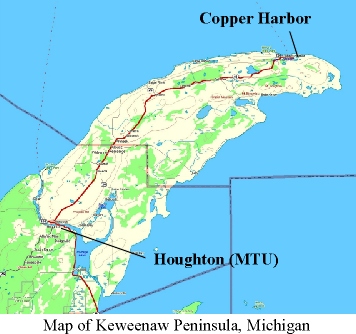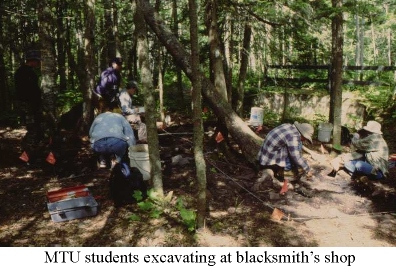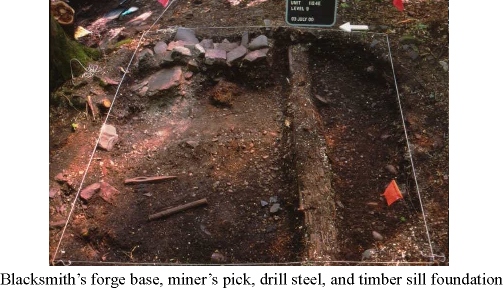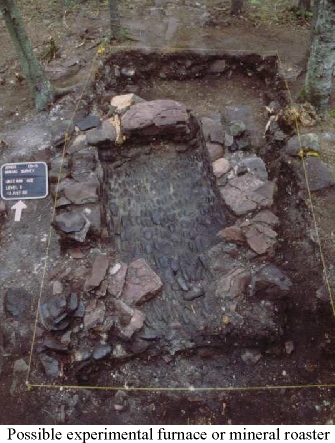

Michigan Technological University's Industrial
Archaeology program conducted six weeks of field survey and test
excavations at Fort Wilkins State Park (20KE13), Copper Harbor,
Keweenaw County, Michigan during June and July 2000. The fieldwork
was part of a two-year cooperative agreement with the Michigan
Historical Center to train undergraduate and graduate students
in archaeological methodology on state lands. Students from MTU,
Eastern Michigan University, George Mason University, and volunteers
participated in the field school, directed by Drs. Patrick Martin
and David Landon. Michael Madson and Elizabeth Norris, graduate
students in the IA program, supervised undergraduate students
in field survey and excavation methodology.
The Pittsburgh and Boston Copper Harbor Mining Company was one of the earliest copper mining concerns on the Keweenaw Peninsula. The company mined copper-bearing silicates at Copper Harbor between 1843 and 1847, until operations were transferred to the much more profitable Cliff location. The workings at Copper Harbor were sizable; at times the company employed up to 70 men. According to contemporary accounts the company employed, in addition to supervisors and contract miners, blacksmiths to produce and repair mining tools and coopers to make wooden barrels to transport ore to eastern markets. In addition, at least two contemporary authors suggested that the company construct a smelter to process some of the poorer ores on-site, considering the costs of shipping these ores to market. One source even mentions that the company had the necessary materials to construct such a furnace. Although the company proposed to build a smelter along the banks of nearby Fanny Hooe Creek, commanders of Fort Wilkins, a U.S. Army outpost adjacent to the mine operations, denied the request.
 Students
and faculty identified two areas during field survey to be the
focus of test excavations. Upon further excavation, one area was
determined to be the company's blacksmith shop. Tabular red sandstone
and yellow firebricks represent a probable forge base. The diverse
artifact assemblage at the blacksmith shop area included window
glass, a pocket knife, iron scrap fragments, bar stock, and numerous
mining tools including a complete miner's pick and drill steel
bit, blacksmith's tongs, an iron file, a maul/sledgehammer, and
the handle of a bucket typically used for lifting ore from the
mine. Also present are blacksmithing by-products, including coal,
charcoal, ash, limestone (for flux), and slag. A bladed reaming
tool, possibly used to drill bung holes in wood barrels, hints
that a cooperage was either included at the blacksmith shop location
or in the vicinity. Building remains included an intact timber
sill and substantial architectural nails and spikes. A charcoal
pile nearby, 1 meter thick, represents fuel storage for the blacksmith's
forge.
Students
and faculty identified two areas during field survey to be the
focus of test excavations. Upon further excavation, one area was
determined to be the company's blacksmith shop. Tabular red sandstone
and yellow firebricks represent a probable forge base. The diverse
artifact assemblage at the blacksmith shop area included window
glass, a pocket knife, iron scrap fragments, bar stock, and numerous
mining tools including a complete miner's pick and drill steel
bit, blacksmith's tongs, an iron file, a maul/sledgehammer, and
the handle of a bucket typically used for lifting ore from the
mine. Also present are blacksmithing by-products, including coal,
charcoal, ash, limestone (for flux), and slag. A bladed reaming
tool, possibly used to drill bung holes in wood barrels, hints
that a cooperage was either included at the blacksmith shop location
or in the vicinity. Building remains included an intact timber
sill and substantial architectural nails and spikes. A charcoal
pile nearby, 1 meter thick, represents fuel storage for the blacksmith's
forge.
 The
second study area appears to be the remains of an incomplete or
short-lived furnace or roaster for the processing of copper-bearing
ores. Cultural materials, particularly an intact drill steel similar
to the one identified in the blacksmith shop location, indicate
the area was indeed part of a mining operation. Domestic artifacts
included mid-nineteenth century, sprig painted polychromatic English
whitewares. The sizable three-sided feature, approximately 1.5
x 3 meters, with walls constructed of tabular, rounded, and subangular
basalt cobbles and tabular red sandstone chunks, has a floor of
small, flat, and rounded cobbles, set on edge. Yellow firebricks
and structural, tabular red sandstone fragments from the features
deflation are present within and north of the feature. Artifacts
inside the feature included an iron file, clear bottle glass fragments,
square-cut nail fragments, and a lead ball. The feature appears
to be a furnace or hearth, however, except for a few fragments
of burned limestone and melted glass in the fallen material, the
interior exhibits no signs of fire.
The
second study area appears to be the remains of an incomplete or
short-lived furnace or roaster for the processing of copper-bearing
ores. Cultural materials, particularly an intact drill steel similar
to the one identified in the blacksmith shop location, indicate
the area was indeed part of a mining operation. Domestic artifacts
included mid-nineteenth century, sprig painted polychromatic English
whitewares. The sizable three-sided feature, approximately 1.5
x 3 meters, with walls constructed of tabular, rounded, and subangular
basalt cobbles and tabular red sandstone chunks, has a floor of
small, flat, and rounded cobbles, set on edge. Yellow firebricks
and structural, tabular red sandstone fragments from the features
deflation are present within and north of the feature. Artifacts
inside the feature included an iron file, clear bottle glass fragments,
square-cut nail fragments, and a lead ball. The feature appears
to be a furnace or hearth, however, except for a few fragments
of burned limestone and melted glass in the fallen material, the
interior exhibits no signs of fire.
The two industrial, mining-related sites have a great potential to provide important information for this early period of mineral extraction in the Copper Country. Documentary evidence for the company's occupation of the Copper Harbor location is slight, and archaeological data from the sites may cast bright light on the company, its workers, and their techniques. The artifact assemblage may also reveal much about the transportation of goods, people, and minerals between the East Coast and Michigan's Upper Peninsula. Please feel free to contact Dr. Patrick Martin (pem-194@mtu.edu) or Michael Madson (mmadson@loucksmclagan.com) if you have any questions, ideas, or comments, would like additional information, or are interested in participating in future excavations at the site.